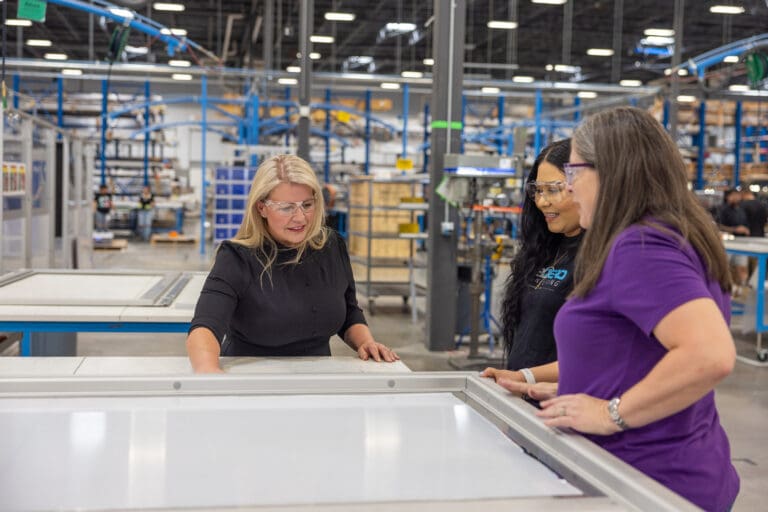hello everyone thank you for tuning in as always I am Katie batesman the content director at chican code and
today we’re discussing how HR Tech can be used to promote de and I within
organizations HR Tech is a general term that refers to suffering Hardware covering a range of
HR functions to give us more insight into this today I’m joined by Sarah Holmberg head of HR odd winning attempt
today to take a look at how HR Tech can improve diversity and inclusion and why
we should be looking at the nordics for more inspiration welcome Sarah thank you so much thank you so much for
coming along and agreeing to have a chat with us today and can we kick off with a little bit of background about yourself
please yes sure definitely uh my name is Sarah honberg and I live and I work in
Gothenburg in Sweden it’s on the west coast for those of you who don’t know exactly where Gothenburg Sweden is I
have quite a broad background from where I started studying law at the University
thinking I’d be working as a as a business lawyer but when I graduated back in 2000 I
quickly got hooked on the people part of business so um by now I have quite some years of
experience from a wide range of Industries and sizes been working as a consultant for many years and both
Global and local companies and for the last eight years I’ve been working in tech companies as HR business partner
and also head of HR So currently I’m a head of HR at the
Swedish sauce Scale app and HR tech company called winning temp as you said
and before winning temp I was head of HR at a company called fingerprint cards
it’s within Biometrics for smartphones credit cards computers and wearables and
so in the tech industry for quite some time fantastic and um we we always start
these podcasts with just one in here where people have people got into Tech and where they came from so it’s
interesting that you originally studied law um I’m assuming is that something that
you saw as a young student and you thought that’s that’s for me and perhaps nobody had pointed out the tech industry
to you at that age that’s that’s a interesting question because I I don’t think I was uh ever
thinking that I would be working in tech industry yeah yeah and and I listened into uh one of
your previous uh podcast episodes where you were talking about just that that you you can how you develop throughout
the years and uh take different paths so learning from past experiences and I
think for me that is exactly what happened that I I studied uh law thinking and I knew what I wanted and
then I um I started my first job got into the area of global Mobility so
still working with the some parts of the legal aspects of people but starting
with global Mobility also tax issues employment law and so on but then
gradually moving into more of the HR business partnering and started love
really working with the within the field of HRS which is really really broad so both like compensation benefits and so
on so it’s been a journey yes yes and you finally found yourself in in the tech sector and but also
you’re quite uh you’re in quite a um a niche area as well and I think a lot of people probably don’t quite know
um what HR Tech um actually entails so could we kick off our conversation today with a bit more about what is HR Tech
can you explain it to our listeners and yes um I will give it a try
um how I see HR Tech is um the digital tools that we we use
within businesses to help manage the HR work and our processes from attracting
new candidates to recruitments to hiring to Performance development to
benefits how we handle the master data gdpr and so on and so all of that is
what we would call fall under the umbrella of HR Tech and I think what has become really
important in this area is to to facilitate to streamline to automate as
much as possible so reducing admin allowing for organizations to spend more time on more strategic work instead and
and also for for HR professionals to be true HR business partners to the leaders
of the of the organization and and perhaps not everyone knows or
have heard about winning temp and what it is that that we do uh but uh we
started as a business in Sweden in 2014 where we wanted to change how
people succeed together and looking through our Founders they they saw a
real problem in companies using annual people surveys
where um you ask employees once a year how they are experiencing their work
situation and then you start working with the result of this annual survey
but what can you really get from that so uh they were more our Founders were
looking to see if we could find a way to constantly have the conversation going
in the organization through frequently asking questions and picking up signals
taking action and and based on science that’s what we
are working on so we’ve developed a platform that helps leaders and organizations understand how their
people are experiencing their work situation every day basically oh amazing yes that that makes so much
sense because I think um people see that that annual survey dropping their inbox don’t they and they
think was that that survey again um and you you feel differently throughout the year about your work and
you know the what it might be that you’re working on at that moment in time so you’re right to have that conversation going all year you would
gain such an insight into actually how your employees are feeling rather than
um say you sent it at the end of the year and people are feeling a little bit hopefully not burnt out but they’re feeling a little bit like I just need to
finish the year for Christmas um but they would feel completely different perhaps
um mid-year so that’s absolutely makes sense and what we encourage our customers and
what we’re also doing ourselves we use the the tool and the platform ourselves as well of course and we encourage our
customers to use six questions per week um to to ask the organization and the
people how they’re experiencing um their work situation and our product
is unique because we don’t ask the same questions um throughout the organization so if you
and I were working in the same team you would one week receive completely different questions from the questions
that I receive because we both experience the work situation differently
yeah so as an example if I get a question related to how I’m experiencing
stress right now uh I could possibly today be responding negatively to that
question and then next week I’m uh ex I’m I will receive a follow-up question
because the system the AI will will identify then if if there is a trend
going here or if it was just oh she was just stressed that one day because it was a rough morning with the kids so
whatever so it’s it’s actually asking relevant questions so it’s uh it’s super
I see yes so the the the feedback from that must be incredibly Rich once you
you put it all together yeah and and see the difference in answers um that sounds great so many companies
they’re frankly hiring more diverse candidates now um but what is the next step do you
think to a successful de and I strategy I think you need to uh link the Dei
strategy to your business strategy really reflecting on
um who who are we really and who are our customers so looking at where we are
today um reflecting on both our customers and
also potential candidates so before you set the strategy you need to look yourself in the mirror I think and Link
it as I said to the business strategy um I think really important is to uh now
what you could call it the skills shortage or that we are not using the
full potential of the skill out there and skills out there and identifying your strategy what skills do you really
need and how do we find them can we broaden our view um what are we potentially missing are we
using the entire talent pool or or can we look somewhere else and what what we have done at at winning
temp ourselves is that we before we go in and and um start a new recruitment we always do
what we call a diversity check and it’s not a diversity check only looking at like gender and and uh
ethnical background and so on it’s from all perspectives so really age gender education industry what what uh are we
potentially missing in these teams to to really add on so more of a cultural
cultural and and the diversity add-on to the team that we are missing today and
and I think the important thing there is to to um to reflect our customers
that’s super important so knowing um knowing why really do you have a Dei
strategy what is it that you want to achieve yes I love the fact that you said link
the Dei uh d e and i strategy to the business strategy because you you’re
absolutely right I think more companies are doing that nowadays um but it is uh slow but more companies
are doing it but I think years ago when this conversation started it felt like it was an after fault wasn’t it it was
kind of an add-on oh we need a diversity strategy um you know some somebody
somebody HR take care of that you know it wasn’t actually as you said built into the whole business strategy and how
that relates to your customers and how your um uh employee base can you know needs
to reflect your customer base um because that’s who they work for
um and they’re the people that are gonna be able to to translate you know what you guys do and best to to your customer
base and it’s something that for a long time I think companies just really didn’t think about did they but as as
you said now you know a lot more companies um are building it into that that business strategy yeah and I think also
looking really hard on uh what does our
um leadership uh structure look like today is there a a fair share of both
women and men in the leadership roles because I believe I think when we’re also recruiting if you can if you can
see someone that is that you can mirror yourself in and then you know that you
can also achieve it so if we have a more equal base on on of both women and men
in leader positions then that will in self in itself also attract a more
diverse um a more diverse Workforce
yes yes I completely agree with that and and when you go for the interview as well
um whether or not there’s somebody there that you you think you can relate to um and uh it gives you a real sense of
whether or not you just feel you’re going to get on with those people day to day as well um and and have similar
conversations and beliefs and um and a similar drive for that business
strategy if we’re linking you know it also to uh to HR tech and and uh looking
to what what what can you do of finding out where we are today
um in uh in a tool like like our tool that we’re using uh ourselves as well is
that we can actually identify how our different age groups are responding to the questions how are
the women how are the men responding how are the non-binary uh and also asking
quite concrete questions regarding how you experience uh diversity within your
own team within the organization as a whole so we can really take the temperature on on that as well which I
think is really really important stuff to uh to use for your uh your uh when
you’re working on the strategy which is really really useful so because I I was going to ask you know how can HR Tech
help fix gender equality and help fix the problem within the workplace but as
you said there you get a real temperature as as you said um of how a
workplace is feeling um and and where you need to make changes and you mentioned age but I
suppose and that’s just one example isn’t it that also relates to gender inequality as well yeah definitely and
and other things I think there are so many great atrial Tech tools out there
and that would be helpful when when working on the the gender inequality uh
problem here because I I think starting from job ads uh what we have just now
started using a tool where we can actually check the job ad for language
and tone of voice uh have we written it so that it’s it’s coded more masculine
or more feminine uh can we make changes to that so there there’s just so much there and also in our recruitment tools
we can eliminate names gender take out photos and so on
to reduce bias so I was looking at one example here from my talent acquisition manager and she showed me a an example
of of a name of a person or the name was removed and the person is instead called
dolphin sky blue and this is through team Taylor so it’s also a bit of humor
into it but it’s reducing it’s eliminating um the unconscious bias to that which I
think is is a great way of actually promoting more diversity in the
workplace yes so you only see them for their skills and what they can offer exactly yeah I I’ve heard that before
about you know if somebody sees a CV and it has a name which perhaps they can’t
pronounce or you know you kind of people think they have certain things that they think
um and they might um just disregard a CV and it could have been a really talented person I need to think oh buy
it why do it I know I know yeah you’re absolutely right and also adding
um like HR Tech tools like for personality tests and logic tests take
them early in the recruitment process because that also eliminates uh the uh
or reduces unconscious bias if you’re you’re using the tests early
and there we have a really good collaboration with the Alva Labs who are
the super and the personality test and logical tests yeah yeah and so it’s all of that is
is before you get into a company and then once you’re in a company I mean you’ve spoken a little bit um already
today about you know surveys and making sure and that they if that conversation
is going on all year um but do you think it’s important that employees have a voice in the workplace
or is it just you know you just get in and you do your job and that’s it no definitely and that’s our entire it’s in
our DNA of course as our product is about actually listening in uh so having
the uh the possibility to to check in on each other regularly is super important
and that’s I think how how are we supposed to create high performing teams if we don’t know our teams and I think
knowing on on all levels so both allowing for the and on Anonymous uh
answers and comments like you can give been in the pulse survey but also of
course the the one-on-one check-ins and so on that you have that’s that’s super
important so for for us as uh as an HR tech company and and
listening in to uh to our people that’s that’s the entire idea
um and expressing your your voice then you feel valued you have an increased job
satisfaction you feel that you can influence and you also have better opportunities for the development
because you have raised your concerns and doing that through uh an HR pulse
survey like winning template and you constantly have the information you have the data and you connect on it
you know it’s really interesting there as well that you just mentioned one to once um because I suppose having that mix
that that one to one where you can speak to to your manager regularly
um but also having a survey where you can just fill something in and be anonymous and and and you know I wanted
to ask you a bit about what can organization do to create a safe and comfortable workplace but I suppose
actually having that mix of being able to to share your voice in different ways because you might not share certain
things in your one-to-one that you would share in an anonymous survey yeah so
true and uh of course in the best of Worlds you would have everything openly
and you would always have full trust between manager and employee and between
employees from different teams and so on but we uh of course sometimes need to raise uh
things that we perhaps don’t feel feel comfortable of having my name on it but
I still want to raise it so I think it’s super important that we have that alternative and
to create the the safety at the workplace I think the
um generally caring about your people and showing that yes you’re in your day-to-day work as a manager but also
showing that you care as an organization so if you have decided that you will
have these pulse service checking in and so on what do we do with the result do
we talk about it in our teams and because otherwise it’s like sending in my comments into a big black hole you
have to also work with it and and generally put people’s people’s first people first because I think
understanding as an organization that the well-being of our people if I feel
and that I’m being listened to that I feel that I’m involved I will also perform better so it will be linked to
business performance so it’s business it’s not just being nice to people it’s it’s hard business
and in fact you said actually making sure that you talk about the results
because surely you know some people they must work at companies and they think yes I answer these surveys all the time
but nothing happens there’s no action so suppose it’s just looking for that action that you know once you’ve been
there a year and you’ve taken so many surveys that you can actually see change the next year around yeah
yeah I think HR Tech and uh in this format the uh the pulse survey is is a
help for you but you have to uh to put in some work as well as team members and
as Leaders to really discuss and talk and and work on the actions
but you get really good insights so you don’t have to do all the work yourself so you get the insights from the product
but you you need to take take action make make it make the improvements in
your team yes I suppose it’s not just thinking oh you know what we we have this uh great product and we’re in HR
Tech where we can just get people to answer surveys and that’s it we’ve done our part
um we’ve got some great Insight but we do nothing with it um do you think there are negative uh
connotations and stereotypes around HR that need to be addressed uh to allow
more a more inclusive culture I think it’s really important that HR is
in sync with the business strategy and also I think clarifying to both employees and leaders uh what the role
of HR is in that organization because when
um you you may come from from a background where HR has been more of a
uh a go-to department or person when you have a problem
but you could also come from a more mature organization where HR is a true business business partner and really the
the right hand of the the CEO so really from from HR perspective clarifying uh
what it is that is our mission and and the role in in our company and regarding
the diversity and inclusion in this matter again I I don’t think I could
stress this too many times and tell the organization what you’re doing and
linking it to uh to watch what it is that you want to achieve as a company
why is it that we believe in diversity why is it that we believe in a more
inclusive workplace and making sure that there’s a red thread throughout not just
when you’re recruiting but also during the life cycle the life cycle of an
employment so that you see that we’re actually taking action and one example there I think from what
we recently did here at winning temp we had a really good all company dialogue
we did it online but we had different groups around uh some of the areas that
we have identified within our workplace that is super important for us to work
with diversity and inclusion for example when we work at different offices we come from different countries and we
speak different languages how do we make sure that everyone feels included so involving the organization and that and
there I think HR can be more clear on what it is that we can contribute with there
yes I love I love everything you just did there because I completely agreed that I think a lot of people they see
CHR as uh you know you you have your first interview with your screening you get in and then you might go to them as
you said if there’s a problem or something negative um and then you might have an exit
interview if you’re lucky and that’s it I completely agree with that it’s it’s there to have that conversation
throughout your whole time to make sure that you that HR are working with the
business to make sure that you’ve included throughout the whole time that you’re there at that company
um instead of just you only see them when you enter and and you leave and and that’s it um I completely agree with
that and to make that that culture feel far more inclusive
um we’re nearly out of time and I’ve got one more question for you um I wanted to know Nordic countries are
leaders in workplace gender equality and why do you think they’ve been so successful
um good question and uh I think uh I can speak from from my experiences from from
Sweden and and what I see and of course we still have a lot of challenges here as well but if we look at Sweden alone
we have uh really generous parental leave practices and that is uh I mean
it’s it’s regulated by the government and we have child care for all so it’s
uh super uh I mean it’s it’s subsidized so it’s not depending on your uh your
income so it’s uh it’s available and you know that you will have a place for your
child um quite nearby to where you live and we also have a high ratio of women
workers in in Sweden and have had for a long time so it’s more of a standard that both women and men
um work at an equal ratio
um I don’t know if that’s how you would express it but I think also um I don’t know if you’ve heard of Pippi
Longstocking yes yes and and this book written by the Swedish
author Astrid Lindgren in the 1940s uh I mean it’s about a girl growing up in her
own house with her own rules without parents present challenging both gender Norms speaking her mind she’s really
strong Independence breaking the rules and this is what’s both Swedish girls and boys have grown up with for
Generations now and uh and still Pippi is seen as a like a role model and I
think that has something to do with the culture that we have here and the quite
um I mean we have a flat organization structure I would say
throughout Sweden as a Swedish norm and where we have more of the consensus
involving people in in decisions and feeling people feeling included I think
that’s actually um helping out on the gender equality as
well to feel included and we also have that’s also regulated
by law that we need to make annual reviews on how our salaries are
um when we compare we have to make sure that there are no discrimination um based on gender in the salary
structure that we have and that’s we have to do annually just to make sure that there is no structural
uh structure um in differences
yes there are all great things um that oh you know obviously work
together um to to make the nordics a leader in that area
um there are so many great things that that you mentioned there one of them was Role Models which I think is so
important to to be able to see uh you know for young girls to be able to see
those leaders um as to you know like you said who who they’d like to be
um when they’re younger um and and you know yourself as as uh as
a leader in that as well I’m I’m wondering you know if that if our listeners are thinking how how do I you
know get into this this type of area um you know how do I work in this type of area I take it you don’t have to be
technical to get into it you know yourself you don’t have a technical background that’s that’s a misconception
isn’t it that you have to have to be technically minded to come into these these sort of areas in technology you
don’t do you and now we we definitely have a lot of different uh roles within our company so
just because you want to work within the tech industry you don’t have to have a
full Tech background of course um but um if you’re interested and and curious
I think that should lead and lead the way and and if you have a background
within Finance why not try out to to work with and find us at the tech company for a while but it’s high high
Pace I would say for where where I’m at so
um it’s not for everyone but if you if you’re interested in in change and like
to be part of building something then it’s it’s super interesting yeah yeah
well that is lovely a lovely advice and a lovely place to leave it because we are already out of time it is absolutely
flown by so thank you so much Sarah for coming in and sharing your insights with us today it’s it’s been it’s been really
interesting thank you thank you so much have a great day and to everybody listening as always thank you so much
for joining us and we hope to see you again next time







